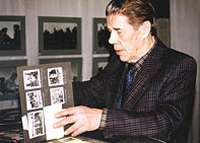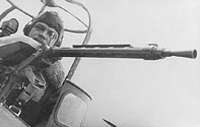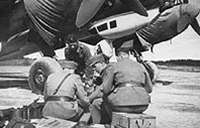| |
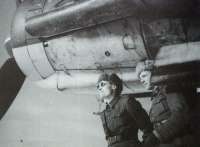 Lauri Äijö And Onni Rautava - Blenheim And Junkers 88 Pilots Lauri Äijö And Onni Rautava - Blenheim And Junkers 88 Pilots
Index:
[ Squad mates | Flying Blenheim | Dive Into Airacobra Nest | 50% Losses in Six Weeks | Four G's with Junkers 88 Dive Bomber | Bomber Crew Duties | Junkers Bombs and Bomb Loads | Blenheim and Junkers 88 Stores | Missions With and Without Fighter Escort | Mannerheim Cross Knight #182 | Credits ]
Risto Korva and Olli Korhonen, two Virtual Pilots and history enthusiasts from Oulu, interviewed the pilot veterans Onni Rautava and Lauri Äijö at the Lapland Air Command annual celebration at Rovaniemi, in 2002. Both gentlemen served as wartime pilots, first on the Blenheim and then on the Junkers 88. Mr Äijö was awarded the Mannerheim Cross of his achievements. The interview is brief-ish, for both gentlemen were on their way to sleep. Recording: Risto Korva
Tape transcription: Seppo Tolonen
Proofreading: Jukka O. Kauppinen "Grendel"
English translation: Lt(jg) Markku Herd, Finnish Navy.
 Lauri Alfred Äijö Lauri Alfred Äijö
Captain in reserves
Finnish Flight Badge Honoris Causa, K 138, awarded 8.9.1940
Born May 17, 1917 at Kauhajoki
Navigator training: Navigation Course 2 at the Air Warfare School Dec 11, 1939 - Mar 12, 1940
Knight of Mannerheim Cross
Freedom Cross 4th Class Jul 27, 1941; Freedom Cross 3rd Class Mar 27, 1942; German Iron Cross 2nd Class Aug 26, 1943.
In Squadron 44 as navigator since the beginning of the Continuation War.
Conscripted Oct 3, 1938 in Field Artillery Regiment 3; to Air Warfare School on Dec 11, 1939; 2ndLt in reserves on Dec 22, 1939; to Flight Squadron 44 on Jun 17, 1941.
On May 13, 1942 to Squadron 48, to the newly established separate air photography wing. Back to Squadron 44 on Dec 10, 1942, where flew the JK-256 until the end of the war. 110 war missions. Onni Birger Rautava
Machine gunner/radio signalman badge #47, awarded Dec 28, 1942.
Born Mar 9, 1920.
More stories by the same gents: Literature:
Squad mates
Did you serve in the same squadron?
Rautava: Yes, even in the same squad. For a while.
Äijö: We spent half a year in the same squad.
Rautava: Yeah. Flight Squadron 44.
Äijö: And again at the end.
Rautava: In Ahtiainen's Squadron 48.
Äijö: Yes, in Ahtiainen's (squad), but after that in JK (Junkers 88) days we were in the same squad again.
Äijö: There was a Flight Ahtiainen in 42, that was maintained and given service by Squadron 42. But the orders and assignments came from elsewhere.
Flying Blenheim Rautava: The book 'Isänmaan puolesta Mannerheim-ristin ritari 1941-45' (=For Fatherland, Knights of Mannerheim Cross 1941-45) ends in three words that I always remember - 'Äijö, Lauri, Mikkeli'.
Lauri told mostly of these photography missions and long range recon flights. He was in Ahtiainen's photography flight back then. And I told of my feelings, some incidents. Like when four fighters came from the sun. And I was suddenly amused, 'oh, this is now what I've heard so many times, feeling a cold ring around your arse'.
Cold ring, right. The most horrible feeling there is, but fortunately it didn't take long. It happened over Lotinanpelto, when we were doing night raiding. We were caught in a beacon and then AA shells went off all around in the darkness. For a while it felt lonely.
What plane did you fly then?
Rautava: The Belnheim, I was the machine gunner-signalist in the back. It was an eternity before we got out of that light. Or the beacon lost us, dunno which way it was.
Did you dive out and away? How high were you when the beacon found you?
Rautava: I seem to recall we were at three kilometers then.
Didn't you usually go into dive, if fighters came at you in daytime?
Rautava: It depended on the situation. If there were clouds near or above, we went in them. At least I was in one escape when a Chaika was by us, I don't think it was even 50 meters away because I could see the color of the pilot's eyes. It was flying in the same direction, right under clouds. Then the pilot turned his head and then his plane. I said, 'pull up and then to the right!'
Victory! The Chaika came like this, we rose and went cross-wise. We flew (in the cloud) for a while, then I said to the pilot, Valto Laurila, 'we can continue, it won't find us any more.'
Dive Into Airacobra Nest 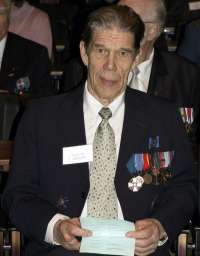
Onni Rautava. Photo by Risto Korva. | Rautava: Once there was a Russian Pe-2 after us. It wasn't quite like in the pictures, but then there were four versions of the Pe-2. This one looked strange. I reported that there was a plane like Pe-2. "Is there anything else?" the Captain in the cockpit asked. "Well, there are four Airacobras too." And then we went like this (gestures a dive).
The earphones were blocked in the dive, there was only static. The pilot levels out near ground, and I ask, "what the hell was that about?!" "Don't you think there was a reason?" "Yes but, goddamnit, you take orders from behind in situations like this! You don't know there in the front what's back there! You went right into their lap!"
You see, these Airacobras had been below us. Fortunately for us, the Red Army pilots didn't stray from their own mission. They kept escorting their own plane. We would have been easy prey for them, they were faster planes.
Yes - and the Airacobra's cannon was big enough to hurt if hit.
Rautava: Yeah, I don't think I'd be here now...
50% Losses in Six Weeks What other planes did you have?
Rautava: The Squadron 42 had only Blenheims all the time. For a while we had a Kotka as a courier plane. It was an old-fashioned, two-seater recon plane. It was used for visits at the Regiment HQ, jobs like that.
Our plane losses were 50% in six weeks. We began with ten planes, and after six weeks of hostilities we had five left. A couple of weeks later we had only one in flying condition. Russkie fighters raided the Wärtsilä field and destroyed one plane completely. It exploded and damaged another plane badly. But then we got more, the factory made 57 Blenheims in all. The licence was for 50 planes, but they made 57. Two were numbered after a destroyed plane.
Recycling old plane numbers. Was the 101 the first Blenheim made for us?
104 and 106 were still in use in the Continuation War. The numbers began from around 100 and continued well over 150. When Squadron 46 got their Dorniers, their Blenheims were transferred to 42. And when Squad 44 got their Ju-88's, their old planes were moved to Wärtsilä. So when our bomber regiment had 21 planes in June 41, in June 44 we had about 80. Even if we had lost so many planes. We got these 50 new ones, then we had some of the old ones left, and we also used captured Russian planes, SB's and DB's.
Some of those we got from Germany. Some we caught ourselves, planes that had made forced landing. Perfectly useful bombers for us.
Four G's with Junkers 88 Äijö: And we bought 24 Junkers bombers. One fell in the Riga Bay on their way home, 23 arrived in Finland. It was one tough plane, a dive bomber. Starting from 4000 meters, it came in 60 degree angle down, and began leveling off at 1500 meters.
It had an automatic device that did the leveling. It was set to pull back at 4 G's. Your weight went up four times...
Rautava: A hundred kg man weighed 400 at that moment.
Did it make the pilot blackout?
Äijö: No, it wasn't hard enough for that.
Rautava: It happens around 6 G's.
Äijö: I noticed I never heard the engine noise, even if there where two big 2000 horsepower engines one meter away, the other a bit further. I didn't hear them until my ears opened a bit after leveling off.
Rautava: My hearing never quite recovered wartime.
Äijö: The navigator had two gauges to adjust. The speedometer and the altitude meter.
You had to calibrate the gauges on the automata, so they read the same as the actual flying gauges.
You had to adjust it?
Äijö: You had to look at the gauges during the dive, and turn the knobs. Gravity went haywire once we went into dive. Once I saw the JK's 13mm gun's drum clip, that was usually on the floor, was floating in front of my face. I had to remove the clip from the gun and tuck it at my feet. Otherwise, when leveling off, it would have gone through the cockpit plexiglass. (The JK was equipped with a heavy MG or a 20mm cannon, that the pilot could use as a fixed gun or the navigator as a steerable gun.)
Bomber Crew Duties How much did you fly the Blenheim and the Junkers, which one more?
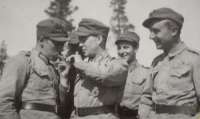
Passing time and rehearsing at Onttola, summer 1943. Left: sgt Onni Rautava. Others sgt Mikko Nikula, sgt Terho Liukko and cpl Toivo Hallaperä. PLeLv 44. Photo from the book Pommituslentolaivue 44 / Lauri Lehtomäki. | Rautava: I was flight signalman, the older title was machine gunner and signalist, but it was changed in '42. That's when we got this badge, the flight signalman's badge.
With me on the course was Eetu Hildén, Finnish Champion in boxing. There was also Aarne Reini, European Champion in wrestling. And Gustafsson, top class sailor. Risto Pohjanheimo, who threw javelin with the best. And who else.
Äijö: Blenheim had three man crew, pilot, navigator and machine gunner. Unfortunately the radio was in the middle of the plane and the gunner had to move many meters to operate it. The JK had four men: two machine gunners, one of which was a signalman and the other had twin MG's in the belly.
Rautava: He lay on his belly and took care of the ventral-hind section of the plane. And the signalman, who sat higher, shot back and up.
Äijö: The radio signalman had two MG's. In a panic situation the navigator should have moved to fire the other. But there were never enough time.
Rautava: Tight quarters.
Äijö: And then there was the 13mm MG, either fixed or operated by the navigator. It was right under him.
Rautava: It was fixed, but the navigator could also turn it.
Äijö: And the navigator originally had a gun shooting forward and up, but it got always in the way and was removed.
Junkers Bombs and Bomb Loads Rautava: The detonation systems were different in the JK bombs. Ours were similar to the Russians, that the bombs had propellor safeties. It came off by airflow and freed the detonator. The Germans used condensators.
Electric detonators?
Rautava: Electric, yeah. When approaching target, the navigator connected wires to a 240 volt battery.
And it charged the condensators...
Rautava: It charged the condensators and, when the bomb was dropped, there was sort of a paw following it for a moment. When it had fallen 10-12 cm, the condensators were connected, and then it needed a small shake to go off.
It made a shortcut and...
Rautava: Yes, it gave the detonator a spark, and it went off.
Discharged the condensator to the detonator?
Rautava: That's right. When a 1000 kg bomb hits, it's quite a blast. There was a partisan training center in the Lehto village, and we dropped some there. We never met any graduates from that particular course. There were 400 meters of barracks on both sides of a road, and the whole regiment bombarded the place.
Total destruction.
Blenheim and Junkers 88 Stores
How big bomb loads the Blenheims and Junkers 88's carried?
Rautava: The Blenheim's load was pretty modest, about 500 kg and...
Äijö: The old load type was the best, eight 100's (8 x 100 kg).
Rautava: Yes, that's how it was. The bombs the Blenheim originally carried was this 250 lb bomb, about 113 kg. There were four of them, that's 450 kg. Then the small 12.5 kg ones in the wings.
(Ed: Blenheim did have bomb wells in the wings for smaller bombs. For some reason this fact is often ignored or not noticed. The hatches are between engines and fuselage. The orginal "1-sarja" Blenheims did have them too, but they were open as was the main bomb well in the fuselage. -Kari Lumpio)
Äijö: On the other hand, the JK could carry two 1000 kg bombs, or four 500 kg's. And the hull could carry ten 100-kg (50-kg -Ed.) bombs. As long as you didn't go over the maximum take-off weight limit. If you had lots of fuel, you had to reduce the bomb load, and vice versa. You always had to count it. Usually we carried one 1000-kg and one 500-kg bomb. Some planes had two 1000-kg's. It was a heavy load. A tonner would make a crater of 30-40 meters. They had a cardboard whistle that blew when the bomb fell, the morale whistle. But those tended to get broken, they were made of flimsy 3-4 mm cardboard.
So the Blenheim bombed in level flight?
Rautava: Level, yes.
Äijö: Always level on the Blenheim.
But the Junkers could dive bomb accurately?
Äijö: Then the Germans got a new idea... In the fall-back stage of the war, they removed our dive brakes and we began to do slide bombing in 30 degrees angle. It had the advantage that we didn't need to wait for the brakes to come up, we could go into slide right away. We just had to reduce speed before sliding, or the speed would go too high.
Rautava: Yes, we got through Summer '44 with pretty few losses. Fighter escort was good, and we bombed from too high for small AA to reach.
Missions with and without fighter escort How often did you have to go out with no escort?
Rautava: Usually at the early phase of the war we were without fighters. But then we flew mostly at night or early dawn.
Äijö: We wouldn't have reached our targets if we had no escort.But then we had fourteen escorting planes, seven above and seven below. We were left alone, except for AA.

1944 sunglass fashion. Navigator lieutenant Lauri Äijö (left) and assistant mechanic of the JK-255 Jantunen at Utti in March 1944. Photo from the book Pommituslentolaivue 44 / Lauri Äijö. |
How many bombers usually went on a mission?
Äijö: Sometimes the whole regiment, the Air Force, flew together. We could have a 60 plane fleet going. The actual targets could vary, so squadrons separated to bomb different places. We went together and each came back the way they could find.
Rautava: Early in the war we flew in small formations. I think that in my first flight we had eight planes. I'm not sure. The results were excellent, though. North of Elisenvaara, near the (railway)loading platform, there were tanks in a straight line close together. Three or four aside. Damn lot of tanks in small area. When the place was photographed the next day, it showed them all destroyed.
The next bombing was also at Elisenvaara. It must have been the most bombed place in Finland. The Russians bombed it almost every day and night in the Winter War. Then in the beginning of the Continuation war, we bombed. And in the end, the Russians again.
Äijö: What makes me laugh is that, when they spoke of how I earned knighthood with photos, they never mentioned that it was all high-altitude photography. We went over all battlefronts at 7000 meters, from Hanko to Kiestinki. The Aunus Isthmus twice. Cartography photos. First time in winter '42.
Knight of Mannerheim Cross #182 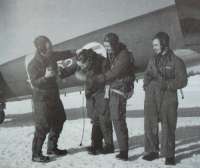
Lauri Äijö and the crew of JK-256 back in Onttola in March 22, 1944. The 100th war flight of Lt Äijö is celebrated by taking a photo, but the modest Lieutenant protests. From left: Capt Itävuori, Äijö, Mäkinen and Mäkelä in front of the JK-252. The photo is from book Pommituslentolaivue 44 / Juha Perälä. | ÄIJÖ Lauri Alfred
Candidate in Agriculture and Forestry, agricultural advisor, director, Captain Dec 6th, '68, Mikkeli.
Born 17.5.17 Kauhajoki.
Parents farmer Albert Alfred Äijö and Maria Sofia Pakkala.
Spouse Anja Eliina Moilanen.
Children Anja Kristiina '49, Elina Inkeri '53 and Pirkko Maria '56
Knight #182, Dec 21, '44, Lieutenant, navigator PLeLv 44.
Vice member of the foundation representarion '76, '77; vice member of staff '77, '87; member '87; region director in Savo-Carelian Dairy Union '56, '80.
AIR FORCE C-IN-C'S PROPOSITION
A proposition signed by the Air Force Commander-in-Chief, Lieutenant General J F Lundqvist in July 7, 1944, and authenticated by the Head of the Air Force General Staff, Lieutenant Colonel R Pajari, to award the Freedom Cross 2nd Class, Mannerheim Cross to airplane navigator, Lieutenant Lauri Alfred ÄIJÖ:
"Lieutenant Äijö has served as a navigator in a long range action squadron since the beginning of the current war, and has so far flown 104 highly successful reconnaissance, photography and bombing missions. The missions have been mostly far in the enemy territory and therefore required daring, consideration and, in many occasions, special cunning. When bombing enemy airbases, service depots and supply lines, Lt Äijö has demonstrated exemplary courage and skills. As a reconnaissance pilot, Lt Äijö is especially trustworthy and capable of independent decision. Of Lt Äijö's performance:
Early 1942, Lt Äijö specialized in regional photography and performed it in southern Carelian Isthmus, Syväri and Maaselkä. The flights were often done in very difficult conditions, under heavy AA fire and enemy fighter attacks. The extremely low temperature, which can at 7200 meters altitude often fall to -60, -70 degrees, was very trying to Lt Äijö.
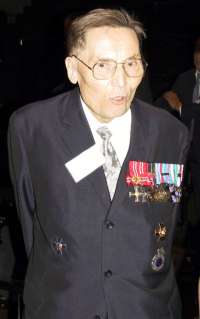
Lauri Äijö at Rovaniemi in 2002. Photo by Risto Korva. | Lt Äijö spent Summer '42 in the special photography squadron dispatched to the use of the General Staff. Lt Äijö proved his skills in surveying railways, roads and rivers deep within enemy territory. These missions often took place 200-300 kilometers beyond the front lines, for example at the road line Osta - Vytegra - Jeshovo - Kargopol and the river line Selo - Roslikovo - Konewo -
Vytegra. The total length of this line is 660 km and the duration of the flight was 4h 25m. Immediately after this flight, Lt Äijö took off on another mission, thus spending nearly 7 hours under enemy AA and fighter threat, which proves his endurance and dedication.
During a photography and reconnaissance flight into enemy territory on August 23, '42, the oxygen mask of the pilot malfunctioned and he lost consciousness. As an officer quick to take action, Lt Äijö took the cut oxygen pipe and pushed it into the pilot's mouth, holding the plane in level flight himself until the pilot regained consciousness. Thus he saved the plane and its crew from certain destruction.
During the recon and photography flights, Lt Äijö's plane was often harassed by enemy fighters. Thanks to Lt Äijö's perceptiveness and quick wit, the fighters could be led astray.
During 1942, Lt Äijö photographed a total of 70,000 km2, mainly enemy territory and front lines.
Early 1943, Lt Äijö was ordered to long-distance bombing missions, and that's when he his experience awarded him hard and demanding missions, where he could demonstrate his night navigation and bombing skills. For example, on Feb 19, '43, as the navigator of the lead plane he led an attack over the town of Sekehe by flying to target area over the cloud layer and diving through clouds only when above target, thus ensuring complete surprise. When returning, the weather got rough, but he nonetheless led the squadron to home base in its entirety, while other squadrons taking part in the raid got lost.
When Lavansaari Island was bombed on August 17, '43, in extremely difficult weather conditions, Lt Äijö's exceptional skills and experience guided his plane back to its home base, a feat other navigators were unable to attain.
When the enemy launched their major attack on the Carelian Isthmus on June 9, '44, Lt Äijö has constantly flown successful bombing missions against enemy tank columns, troop formations, supply lines and ship convoys.
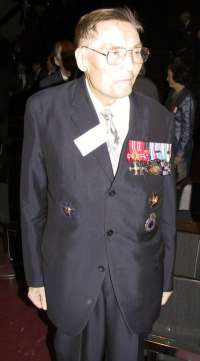
Lauri Äijö.
Kuva Risto Korva.
|
The losses that Lt Äijö's actions have caused to the enemy must be formidable and disruptive to their war efforts. The recon information he has delivered to the High Command have been of great importance. With his war flights, Lt Äijö has been invaluable to the Defence Forces."
The AF C-in-C's proposition was sent to the Defence Staff HQ with the Air Force General Staff registration 2241/Ye.2/3a/7.7.44. The proposition was received at the HQ Personnel Staff on July 8, 1944 (#2162).
PROPOSITION BY CHIEF OF COMMAND STAFF
"By proposition of the Air Force C-in-C, Lieutenant General J.F. Lundqvist, it is suggested that Lieutenant Lauri Alfred Ä i j ö (Le.R 4) is awarded the Mannerheim C 2 ..."
The original date of the proposition list July 1944 is fixed to the actual date of the nomination, Dec 21, 1944.
OFFICIAL REASON FOR NOMINATION
On December 21, '44, the Commander-in-Chief has nominated Lieutenant Lauri Alfred Äijö a Knight of Freedom Cross 2nd Class, the Mannerheim Cross.
Lieutenant Äijö has served through the war as a navigator in a long range action squadron, flying numerous highly successful reconnaissance, photography and bombing missions, mostly against targets deep within enemy territory and therefore required great daring, consideration and often special cunning, due to strong enemy fighter activity. The nature of Lt Äijö's activities are such that their closer inspection is not proper at this stage of war. When the enemy began their grand assault, Lt Äijö has constantly and successfully taken part in bombing enemy tank formations, troop concentrations, supply lines and ship convoys."
Sources:
Air Force General Staff letter #2241/Ye.2/3a/7.7.44
Proposition list #2065, Defence Ministry command department letter #2162/Kom.5/sal.
List of medals awarded by the C-in-C #115/24.1.1945. 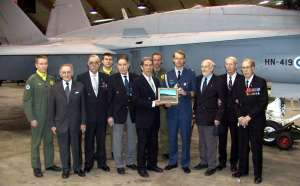
The veterans presented the Lapland Air Command a
plaque, that had sand from the home field of
their old squadron, the 44. Photo Risto Korva.
| |
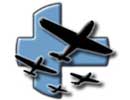

 Lauri Alfred Äijö
Lauri Alfred Äijö